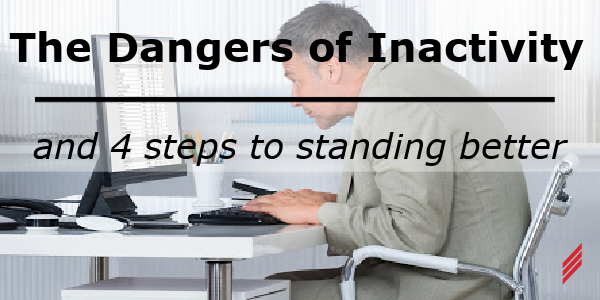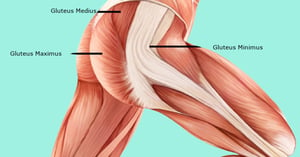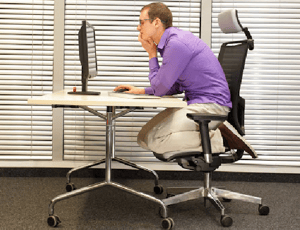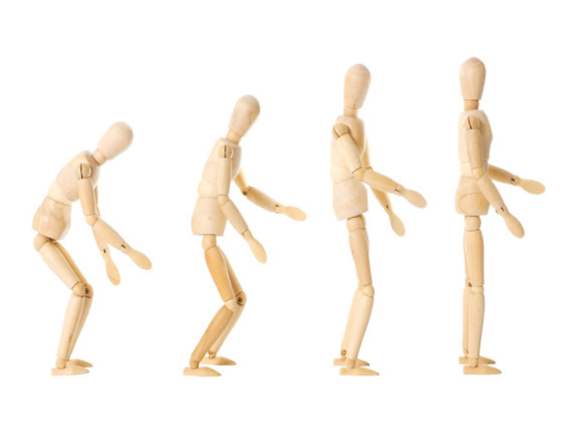The Dangers of Inactivity and 4 Steps to Standing Better
by Dylan Kerkes on Jan 12, 2021 10:30:00 AM

Dr. James Levine the director of the Mayo Clinic-Arizona State University Obesity Solutions Initiative coined the term “sitting is the new smoking.” You may have heard that term and wondered, “What does that mean? That can’t possibly be true?”
Well unfortunately for that comfy new desk chair you just acquired, more and more research is mounting to suggest that a sedentary lifestyle is slowly taking those treasured retirement years off your life.
The World Health Organization has estimated that 3.2 million deaths occur annually due to inactivity, ranking it number 4 in the global list of preventable fatalities. Even worse, studies are demonstrating that exercise will not reverse the effects of long-term inactivity. The positive benefits of those hard-earned 30-60 minutes at the gym are lessened or even cancelled out if you sit most of the waking hours of the day. Think about your day for a moment; how much of it is spent in the seated position? You sit while eating breakfast, during your commute, while at work, driving home, eating dinner, and finally sitting to watch TV. That’s most of your day spent, well, not moving! If you spend 6 hours or more a day sitting you are sedentary. Whether or not you go to the gym or head outside for that 4 mile run.
Why is sitting so bad? It’s not just about inactivity, because you can be inactive and stand all day. One of the main issues with sitting for long periods of time is the systematic shutdown of muscles in your body. It’s an anatomical compromised position, no matter how you slice it. Whether “sitting up straight” (issues 1 and 5) like your mother told you or slouching back into the chair (issues 2-6), it’s not a place you should spend most of your time in. Let’s look at a few problems of sitting:
Short Rectus Femoris/Iliacus/Psoas (Figure 1 and Figure 2): With the pelvis tilted forward when seated the rectus femoris (one of the 4 muscles of the quadriceps), the iliacus (major hip muscle) and the psoas (an important anterior flexing muscle) all become shorter. Think of a rubber band representing a muscle in your body. When you’re sitting the rubber band is relaxed and loose; when you stand the rubber band lengthens to its appropriate shape. Constantly sitting over the course of long periods of time will slowly shrink that rubber band until it cannot lengthen to its full potential. This “shortening” of the rubber band can lead to injury whether you’re active or not. These three tissues will adapt to the position of sitting and become chronically shortened creating issues when you need to extend the hip or stand straight.
- Sleeping Glutes: The gluteus maximus and medius muscles in the backside of your body play a huge role in stabilizing the spine. These are of course shut off when seated. If you picture your body as a building, your glutes are your foundation. Without them nothing is supporting the rest of the house. Without the glutes your spine will become rounded while seated.
- Rounded Spine: With the glutes off and the pelvis rotated forward, the back becomes rounded. You don’t have to know a thing about anatomy to know that’s not how your spine should look. Your spine’s natural shape should resemble an “S” not a “C” shape. Slouching magnifies the issue. I’ve seen enough people toward the end of the work day to know slouching is an epidemic in the workplace.

- Curved shoulders: Your rounded spine then forces your shoulders to arc forward. This can lead to stiff tissue and your pectorals (chest) to become short.
- Low back pain: Has your back ever felt stiff or sore after a day at the office? Again going back to the shutdown of the glutes, your lumbar spine collapses and an unnatural compression force appears affecting the discs of your lower back. Spending most of your time in the rounded C shape can cause your discs to deform.
- Neck Pain: Craning your head forward as little as 3 inches can put as much as 40 extra pounds of pressure to the supporting tissues and segments of your spine. This can lead to upper back stiffness and pain. Along with your spine, your neck muscles also get exhausted from holding your head in that position. Ever had neck pain at the end of the day? It’s probably because your head is off center of your body.
Your body is adapting to its environment. Before you know it, all of these areas become stiff and painful and your body morphs into seated compromised posture .
Alright enough about the gloom and doom; what can you do to make sure your 401K doesn’t go to your in-laws? Well first and foremost to counteract the effects of sedentary behavior you have to move! How do you avoid the compromised position of sitting? That’s where the standing desk comes in. I think most people would agree with me that it’s much easier to move around while standing than sitting in the padded chair or couch you love so much. You’re already in an upright position. There is no added mental effort of getting up out of the chair. We’ve all been in a place where we were seated in a chair “feeling lazy” and would rather email someone in the same building rather than walk over and ask them directly. Standing also makes it easier and more effective to move and continue working. While you’re reading your email you can windmill your arms around, swing your legs back/forth, or shadowbox and imagine you’re fighting Drago in Rocky IV. The options are almost endless.
Standing also places you in a much better biomechanical position. Your body is made to be upright and mobile. No longer are you hip flexors contracted and shortened. You’re now in a place where you can activate your glutes and abdominals. Thus bracing your spine and achieving that coveted “S” shape that will give your doctor a smile during your next physical. So what’s the recipe for standing perfectly? In Dr. Kelly Starrett’s book “Deskbound” he outlines the following procedure:
Step 1: Set Your Pelvis in a Neutral Position
With your feet directly under your hips, toes pointed forward, squeeze your glutes to reset your pelvic orientation. Then rotate your feet outward, your left in a counterclockwise rotation and your right clockwise. You are exerting just enough torque to “screw your hips into the ground.” Not so much where your feet turn outward like a duck.
Step 2: Brace Your Midsection
With a deep breath in, exhale and tighten your abdominals. With your glutes clenched and your abs tight you now have braced your spine. You’re not aiming to tighten these muscles so hard that you pass out. Rather there should be just enough tension that you feel solid. If a young child came up and pushed you, you would not fall to the ground.
Step 3: Organize Your Shoulders
Roll your shoulders back and down toward the floor keeping your arms at your side, thumbs pointed forward. You should feel your chest lengthen slightly.
Step 4: Set Your Head in a Neutral Position
Look straight out at something (not someone, I am trying to teach you a better posture not creep out your coworkers) and balance your head aligning your ears over the center of the shoulders, hips and ankles.
Now you have learned how to stand properly!
It’s important to point out that this is a bread and butter posture. You don’t have to maintain this 8 hours day. While standing solves the issues surrounding the seated position, if you stay in one place whether seated or upright you’re still inactive… I rather encourage you to apply these biomechanical cues to various postures throughout the day. Whether swinging one leg while at your desk, placing one foot in front of the other in a hardbow/warrior stance, or placing a platform under your desk to adopt the Captain Morgan pose, the options are endless. Speaking about the Captain Morgan pose; the office could learn a thing or two about biomechanics from bars. The raised platform at the edge of the bar is to give you options to vary the pressure on your feet from standing while waiting for your drink, but more about that later.
In my next post I will tackle setting up the desk itself and how to incorporate movement throughout the day so stay tuned!
References:
Starrett, Kelly, Juliet Starrett, and Glen Cordoza. Deskbound: Standing up to a Sitting World. Las Vegas, NV: Victory Belt, 2016. Print.
About the Author
Dylan is a driven Mechanical Engineer with experience in both design and project management. He is a graduate of Rensselaer Polytechnic Institute with B.S. in Mechanical Engineering. Dylan holds a 3rd degree black belt in Kenpo Jujitsu. He has coached individuals in self-defense as well as strength/conditioning and mobility.
Read My Hallam Story
About Hallam-ICS
Hallam-ICS is an engineering and automation company that designs MEP systems for facilities and plants, engineers control and automation solutions, and ensures safety and regulatory compliance through arc flash studies, commissioning, and validation. Our offices are located in Massachusetts, Connecticut, New York, Vermont and North Carolina and our projects take us world-wide.
You May Also Like
These Related Stories

Telling Your Story with Self-Publishing

The Wrong Time to Find Out Your Arc Flash Study is Outdated…



Comments (1)